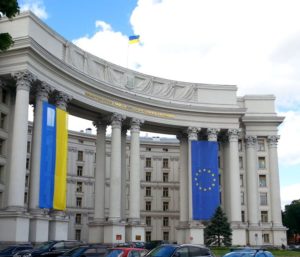Did Poland and Hungary Lose Their EU Pride?
Written by Ivan Laryionenka
A strong, prosperous and proud alliance, where each member is ready to cooperate and work side by side with each other for the greater benefit, and is eager to show off its membership in every way possible – that is how I viewed the European Union before beginning my semester abroad. While Brexit did indicate that not everything might be as smooth as I imagined in the European Union, upon arrival I could not have foreseen how much discord existed between the allied states. I imagined that they all cherished their membership in the European Union and treated it with great pride and enthusiasm.
A trip to the Ukraine right before the start of my program only increased my expectations. After the Maidan revolution of 2013 and the events that followed, this eastern European nation completely reversed its political direction and actively began efforts to ally itself with the West. A strong wave of patriotism along with desire to disassociate itself with Russia and its allies, only pushed these efforts, and now they are visible with a naked eye. Expectedly, Ukrainian flags can be spotted on every street corner, apartment complexes, private residences and of course the government buildings. But what surprised me was the number of EU flags I encountered across the country. The blue flag with a circle of yellow stars can be seen fluttering in front of the parliament building, the presidential residence, both of the municipal town halls in Kyiv and Lviv. If a non-member state of the EU is demonstrating such great respect and enthusiasm for EU ideals, I was sure that I would encounter at least a similar situation once I began our program traveling through countries that are full members of the Union.

Ukrainian Ministry of International Affairs, mfa.gov.ua
To the contrary, upon my arrival to Budapest, the first thing I noticed was the almost complete absence of EU flags in the city. On the drive from the airport I was trying to spot them, yet to my great surprise I saw only a few. Our hotel along with others in the area flew EU flags at the entrance alongside those of Russia, Ukraine and Brazil, yet that was pretty much it. As we began our studies and got to know the city a little bit better, I found out that all government buildings were lacking them as well. The biggest surprise waited for me at one of Budapest’s main tourist attractions, the Parliament building. Not only did it not fly the flag of the EU, but it replaced it with the flag of the Szekely Land, a region in Romania with a large Hungarian minority – a sore point of contention in Hungarian-Romanian relations. At that point, it was clear that the flag situation was in no way a coincidence, but rather a very clear message from the Hungarian government which is known to question EU’s guidance and political agenda.
Hungary’s prime ministe Viktor Orban, after being elected in democratic elections in 2010, along with the rest of the government has been pushing foreign and domestic policies that oppose the European Union practically in every thinkable aspect. His crackdown on liberal values has signaled a complete reversal in the nation’s political course, moving the country in a path away from Europe. In foreign policy, the situation regarding the immigration and refugees remains to be one of the key ones in the European political arena. Yet Hungary has taken a very controversial position and refuses to accept Syrian refugees along with other migrants despite orders and threats of sanctions from Brussels. Orban and his right wing government argue that taking refugees undercuts Hungarian sovereignty by strapping the country with an undue economic burden and is gifting nation’s independence to the EU. On the domestic arena, Orban also found a way to put western, liberal values under threat. Constant attacks on NGO’s along with efforts to close down Central European University are clear examples of a concerted campaign to undermine the foundations of civil society. Making EU flags a rare sight in Hungary is not a coincidence, but rather a very clear message from Prime Minister Orban that he and his government do not want to pursue common policies with the EU and that they will continue to push against them in every way possible.
In Wroclaw, Poland I found the number of EU flags to be even smaller than in Budapest. In fact, after living here for a week, I have only seen one. The local government buildings boast flags with the city’s coat of arms and sometimes are even missing the Polish flag itself. The lack of prominence of the EU flag is not a coincidence. Just like in the case of Hungary, the Polish government is rebelling against the European Union and openly steering away from the common policies that Brussels mandates.
In her first press conference as Poland’s new Prime Minister, Beata Szydlo, a right-wing populist leader ordered the removal of the EU flags from the briefing room. Szydlo, along with Andrzej Duda, Poland’s president from the same Law and Justice Party, have both been pushing foreign and domestic policies remarkably similar to their Hungarian colleagues. Poland maintains a closed border policy when it comes to refugees and migrants, explaining that the taking in of refugees represents a threat to the country’s security and economic stability. Even the danger of legal consequences from the EU has not intimidated Polish government, which completely refuses to change the chosen political direction. Right wing nationalistic parties have seen a jump in support and according to the polls, 65% of population completely support the current government’s political agenda. With the situation like this, the absence of EU flags is again not an accident, but rather is a strong sign that Poland does not want to be ruled from anywhere across the border.

Town Hall, Wroclaw, Poland. (Ivan Laryionenka)
Removing a flag of an alliance that you are a part of is a remarkably simple, yet very noticeable way to display disagreement and protest. The Ukraine uses a similar strategy, but in an opposite way to demonstrate its solidarity with Europe and to demonstrate its ultimate goal of becoming a part of the European Union. Poland and Hungary, on another hand, have taken the blue banners down to make a statement and send a message of discontent to Brussels and the rest of the world.








